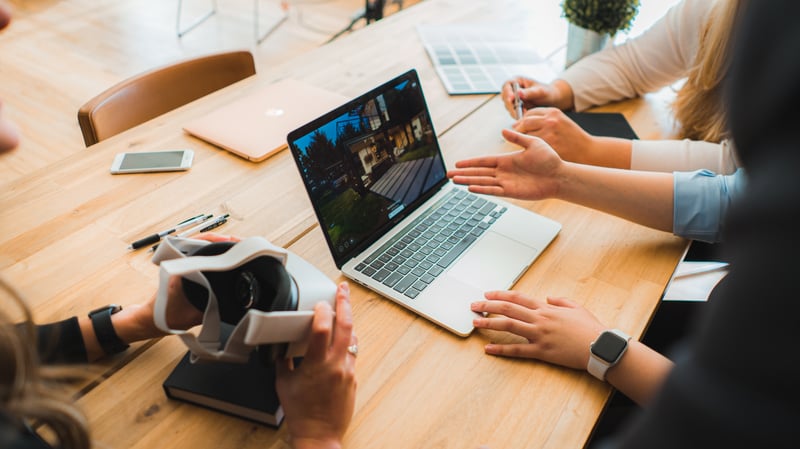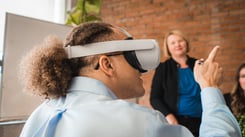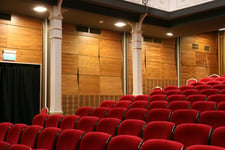Presentations are a key part of any business. Especially those that are client-facing where there is a possible investment at stake. It’s crucial to create architecture presentations that are unique and engaging to stand out from any other firms your prospects might be speaking with. One tool to make your architecture presentation stand out is by using virtual reality or VR elements in your presentations.
By including VR in your architecture presentations, you’ll add a new visual element that:
- Offers an easier-to-understand preview of your projects that even those without a design background can
- Encourages your audience to participate in the presentation and ask questions that may not have come up with traditional visualization methods
- Makes more of an impact and will remain memorable during the consideration phase
Visualize with VR
One of the main benefits of including VR in your architecture presentation is the power VR has to translate a design with complete accuracy into a virtual space. When someone explores that space in VR using a headset, they will get the complete effect of your design with lifelike precision. Create an uncanny realistic experience where size and scale can be better understood. Add lighting and imagery to sell your vision and you can have them explore from multiple viewpoints.
VR goes above and beyond traditional visualization methods. Methods such as models, floor plans, and schematics are still helpful, but they do ask for the audience to imagine the scale of your project, rather than fully see. This could require some general design knowledge that they just don’t have. However, when you use VR as your visualization method, understanding comes just as easily as seeing. Anyone, even those without a design background, can view your project and walk away with a great understanding of your goals and what you see the final product being.
Engage and Explore with Your Audience
When presenting you want to make sure that the audience is actively engaged in the presentation and absorbing the key information. You do not want a passive unengaged audience and so adding an interactive element such as VR is a great way to get your presentation audience engaged. Bottom line: an engaged audience is an informed audience.
There are lots of ways to engage with your audience including asking them questions and pausing to allow conversation and follow-ups. However, taking advantage of a tool such VR will open up a lot of opportunities for you and your audience to interact with each other. Even more so when presented in a piece of software such as Yulio.
Some unique ways that VR can get your clients to engage with your presentation are:
- Movement - If you are presenting in person, asking someone to put on a VR headset will get them up and out of their seat (not necessary to view standing up but it is more immersive). Simply getting someone on their feet during a meeting is a way to get them to engage. As they explore the virtual space, give them both time and space to explore and discover some things for themselves
- Exploration and discovery – As your audience explores the virtual space it is likely they will have questions come up. You may find in fact that by using a virtual reality version of your environment and the enhanced preview that it can provide, people will ask questions that wouldn’t normally be asked if you had used a different visualization method. Questions about the scale of certain aspects will be addressed earlier and you will find yourself discussing things that could have been an issue further in the process
- Showcase Your Design and Expertise – When taking an audience through a virtual reality presentation, make sure to be there to help guide them through it. It is good to give them some of their own time to explore, but make sure you have a plan of what you want to highlight to them. If you’re using VR software like Yulio, you can take advantage of tools within Yulio during these shared sessions that can draw their attention to specific aspects of your projects and showcase the different options. Tools such as a spotlight function and mark ups.
Make a Mark with VR
It is still “early” in the VR adoption phase for most firms in the architecture industry, but only just. Firms are interested in the technology and looking at how to include it in their own workflows and processes. If you don't want to fall behind in bringing the best preview to your audience, now is the time to start experimenting and figuring out how to effectively engage with the tech. 
And while firms are looking at tech, you will find that many of your prospects and clients, may be first-time VR users. If you adopt the tech now, you can introduce them to the technology and make a memorable experience for them. As well if you adopt the tech now and incorporate it effectively into your workflow, people will associate you with the tech and make you their standard for architecture and VR.
At Yulio we recognized the impact that both AR and VR can have in the business world, and we see how these tools could support those who work in the furniture, architecture, and design worlds to bring their ideas to life. Especially in a way that would create memorable presentations for their prospects and clients. We offer VR tools that bring designs to life and allow you to explore and share them in a brand-new way. And we’ve worked with our partners to create AR experiences to show how your products can fit into someone’s design and real-life space.
Want to start investigating VR or AR for your business? We have guides on what VR is, why it might be right for your business practice, how to integrate VR into your existing workflows, tips for selecting the right VR technology and technology vendors, and finally, IT, training, and budget considerations you need to know. Or check out our guide on VR in the buyer’s journey.







